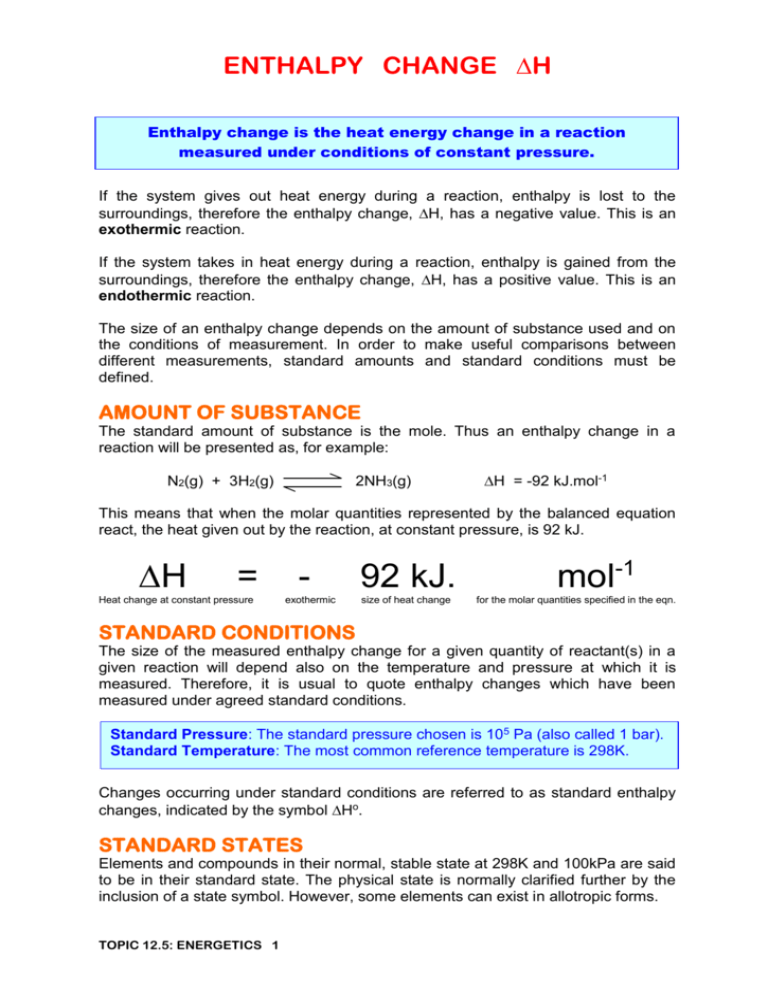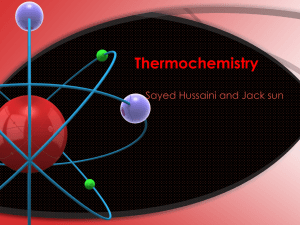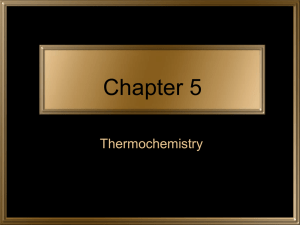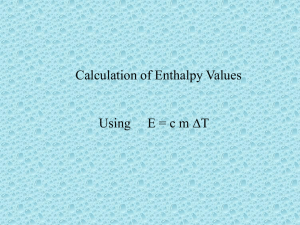ENTHALPY CHANGE DH
advertisement

ENTHALPY CHANGE H
Enthalpy change is the heat energy change in a reaction
measured under conditions of constant pressure.
If the system gives out heat energy during a reaction, enthalpy is lost to the
surroundings, therefore the enthalpy change, H, has a negative value. This is an
exothermic reaction.
If the system takes in heat energy during a reaction, enthalpy is gained from the
surroundings, therefore the enthalpy change, H, has a positive value. This is an
endothermic reaction.
The size of an enthalpy change depends on the amount of substance used and on
the conditions of measurement. In order to make useful comparisons between
different measurements, standard amounts and standard conditions must be
defined.
AMOUNT OF SUBSTANCE
The standard amount of substance is the mole. Thus an enthalpy change in a
reaction will be presented as, for example:
N2(g) + 3H2(g)
2NH3(g)
H = -92 kJ.mol-1
This means that when the molar quantities represented by the balanced equation
react, the heat given out by the reaction, at constant pressure, is 92 kJ.
H
=
Heat change at constant pressure
exothermic
92 kJ.
size of heat change
mol-1
for the molar quantities specified in the eqn.
STANDARD CONDITIONS
The size of the measured enthalpy change for a given quantity of reactant(s) in a
given reaction will depend also on the temperature and pressure at which it is
measured. Therefore, it is usual to quote enthalpy changes which have been
measured under agreed standard conditions.
Standard Pressure: The standard pressure chosen is 105 Pa (also called 1 bar).
Standard Temperature: The most common reference temperature is 298K.
Changes occurring under standard conditions are referred to as standard enthalpy
changes, indicated by the symbol Ho.
STANDARD STATES
Elements and compounds in their normal, stable state at 298K and 100kPa are said
to be in their standard state. The physical state is normally clarified further by the
inclusion of a state symbol. However, some elements can exist in allotropic forms.
TOPIC 12.5: ENERGETICS 1
Allotropes are different forms of the same element capable of existing in the
same physical state, e.g. graphite and diamond.
Where allotropes exist, the particular allotrope should be identified in the balanced
equation; e.g. C (s, graphite) or C (s, diamond). If the allotrope is not specified, it is
assumed to be the more stable form under standard conditions: graphite in the case
of carbon.
STANDARD ENTHALPY CHANGES
The definitions of some standard enthalpy changes need to be
learned verbatim.
Standard Enthalpy of Formation, Hof
The standard enthalpy of formation is the enthalpy change when 1 mole of a
compound is formed from its elements under standard conditions, all reactants
and products being in their standard states.
e.g.
Na(s) + 1/2Cl2 (g)
NaCl(s)
Ca(s) + C(s,graphite) + 3/2O2(g)
CaCO3 (s)
By definition, the standard enthalpy of formation of an element
must be zero.
Many enthalpies of formation cannot be determined directly, because the reaction
concerned does not go, and they must instead be determined indirectly using
calculations based on Hess’s Law.
Standard Enthalpy of Combustion, Hoc
The standard enthalpy of combustion is the enthalpy change when 1 mole of a
substance is completely burned in oxygen under standard conditions, all
reactants and products being in their standard states.
e.g.
C (s) + O2 (g)
CH4 (g) + 2O2 (g)
TOPIC 12.5: ENERGETICS 2
CO2 (g)
H = -394 kJ.mol-1
CO2 (g) + 2H2O (l)
H = -890 kJ.mol-1
EXPERIMENTAL DETERMINATION OF AN ENTHALPY
CHANGE BY CALORIMETRY
The enthalpy of combustion of, for example, methanol can be determined by
burning a known mass of the substance and using the heat produced to heat up a
beaker of water. It is assumed that the heat produced by burning the methanol is
equal to the heat gained by the beaker of water and that heat losses to the
surroundings are negligible.
The heat energy required to change the temperature of a substance is given by the
formula:
q = m c T
where
m is the mass of the substance in kg
c is the specific heat capacity in kJ.K-1.kg-1
T is the temperature change in K
For water and for aqueous solutions, the specific heat capacity is taken to be 4.18
kJ.K-1.kg-1
Example: In an experiment, 0.27g of methanol (CH3OH) was burned in a spirit
burner. The flame was used to heat a beaker containing 100g of water; the
temperature rose by 10K.
CH3OH (l) + 3/2O2 (g)
CO2 (g) + 2H2O (l)
Heat energy produced = Heat energy absorbed by
on burning
water
q = m c T
q = 0.1 x 4.18 x 10 kJ = 4.18 kJ
moles of methanol burned = mass = 0.27 = 0.00843
Mr
32
H = -
TOPIC 12.5: ENERGETICS 3
4.18 kJ.mol-1 = - 496 kJ.mol-1
0.00843
1st Law of Thermodynamics
Energy can neither be created nor destroyed, but it can be
converted from one form into another.
Hess’s Law
The enthalpy change in a reaction depends only on the initial and final states
of the reaction and not on the route taken.
It follows from Hess’s Law, that if one substance can be converted into another by
two different routes, the overall H for the two routes must be the same.
H2
Substance A
Substance B
Route 1
H3
Substance C
H4
H1
reactants
H5
products
Route 2
Substance D
H6
Substance E
H7
H1 + H2 + H3 + H4 = H5 + H6 + H7
Use can be made of energy cycles and Hess’s Law to calculate values for enthalpy
changes which cannot be measured directly.
TOPIC 12.5: ENERGETICS 4
Calculation of the standard enthalpy of formation Hof from
standard enthalpies of combustion Hoc
Example: Calculate the standard enthalpy of formation of ethane, given the
following standard enthalpies of combustion:
Hoc (C2H6) = - 1560 kJ.mol-1
Hoc (H2)
= - 286 kJ.mol-1
Hoc (C)
= - 394 kJ.mol-1
Hof(C2H6)
Method 1:
2C(s) + 3H2(g)
2 x Hoc(C)
C2H6(g)
Hoc(C2H6)
3 x Hoc(H2)
2CO2(g) + 3H2O(l)
By Hess’s Law:
Hof(C2H6)
= 2 x Hoc(C) + 3 x Hoc(H2) - Hoc(C2H6)
Hof(C2H6)
= (-394 X 2) + (-286 X 3) - (-1560)
Hof(C2H6)
= -86 kJ.mol-1
Method 2:
2C(s) + 3H2(g) + 31/2O2(g)
Hof(C2H6)
2 x Hoc(C)
C2H6(g) + 31/2O2(g)
2CO2(g) + 3H2(g) + 11/2O2(g)
Hoc(C2H6)
3 x Hoc(H2)
2CO2(g) + 3H2O(l)
By Hess’s Law:
Hof (C2H6) + Hoc(C2H6) = 2 x Hoc(C) + 3 x Hoc(H2)
Hof (C2H6) = (-394 X 2) + (-286 X 3) - (-1560)
Hof (C2H6) = -86 kJ.mol-1
TOPIC 12.5: ENERGETICS 5
Method 3:
2C(s) + 3H2(g)
C2H6(g)
Hof(C2H6) = Hoc(reactants) - Hoc(products)
Hof (C2H6) = (-394 X 2) + (-286 X 3) - (-1560)
Hof (C2H6) = -86 kJ.mol-1
Calculation of the standard enthalpy of combustion Hoc from
standard enthalpies of formation Hof
Example: Calculate the standard enthalpy of combustion of ethane, given the
following standard enthalpies of formation:
Hof (C2H6) = - 86 kJ.mol-1
Hof (H2O) = - 286 kJ.mol-1
Hof (CO2) = - 394 kJ.mol-1
Method 1:
C2H6(g) + 31/2O2(g)
Hof(C2H6)
Hoc(C2H6)
2CO2(g) + 3H2O(l)
2 x Hof(CO2)
3 x Hof(H2O)
2C(s) + 3H2(g)
By Hess’s Law:
Hoc(C2H6) = - Hof(C2H6) + 2 x Hof(CO2) + 3 x Hof(H2O)
Hoc(C2H6)
= - (-86) + (-394 X 2) + (-286 X 3)
Hoc(C2H6)
= -1560 kJ.mol-1
Method 2:
C2H6(g) + 31/2O2(g)
2CO2(g) + 3H2O(l)
Hoc(C2H6) = Hof(products) - Hof(reactants)
Hoc(C2H6) = (-394 X 2) + (-286 X 3) - (-86)
Hoc(C2H6) = -1560 kJ.mol-1
TOPIC 12.5: ENERGETICS 6
Calculation of the standard enthalpy change for a reaction from
standard enthalpies of formation Hof
In general, for any reaction:
Ho = Hof(products) - Hof(reactants)
Example: Calculate the standard enthalpy change for the reaction:
given that:
Fe2O3(s) + 3CO(g)
2Fe(s) + 3CO2(g)
Hof (Fe2O3) = - 822 kJ.mol-1
Hof (CO)
= - 111 kJ.mol-1
Hof (CO2) = - 394 kJ.mol-1
Ho = Hof(products) - Hof(reactants)
Ho = {(-394 x 3) + 0)} - {(-111 x 3) + (-822)}
Ho = - 27 kJ.mol-1
BOND ENTHALPY
The bond dissociation enthalpy of a diatomic molecule refers to the enthalpy change
for the process:
A
B(g)
A(g) + B(g)
Note that all the species are in the gaseous state.
In polyatomic molecules (those containing 3 or more atoms), it is usual to use mean
bond enthalpy.
Mean bond enthalpy is the energy required to break a particular covalent bond,
averaged over a large number of compounds.
Consider the following examples, which show that the energy required to break a
particular bond depends on its specific environment.
H2O(g)
OH(g)
OH(g) + H(g)
O(g) + H(g)
H = +495 kJ.mol-1
H = +428 kJ.mol-1
The mean bond enthalpy of the O-H bond is +463 kJ.mol-1
CH4(g)
CH4(g)
CH3(g) + H(g)
C(g) + 4H(g)
H = +423 kJ.mol-1
H = +1664 kJ.mol-1
The mean bond enthalpy of the C-H bond is +412 kJ.mol-1
TOPIC 12.5: ENERGETICS 7
Example: Use the data given below to calculate a value for the bond
dissociation enthalpy of the C-H bond.
Hof (CH4)
Hoat(C)
Hodiss(H2)
CH4(g)
Hof
= - 74 kJ.mol-1
= +720 kJ.mol-1
= +431 kJ.mol-1
Ho
C(g) + 4H(g)
Hoat
2 x Hodiss
C(s) + 2H2(g)
By Hess’s Law:
Ho = -Hof + Hoat + 2 x Hodiss
= - (-74) + (+720) + (+431 x 2)
= + 1656 kJ.mol-1
Ho = 4 x Hdiss (C-H)
Hdiss (C-H) = +1656 = + 414 kJ.mol-1
4
CALCULATION OF H FROM MEAN BOND ENTHALPIES
Mean bond enthalpies can be used to calculate the enthalpy change in simple
reactions. Since mean bond enthalpies are used, the value obtained is only an
approximation.
H = Hdiss(bonds broken) – Hdiss(bonds formed)
Example: Calculate the enthalpy change in the reaction:
N2(g) + 3H2(g)
2NH3(g)
Hdiss(N N) = +944 kJ.mol-1
-1
Hdiss(H-H) = +436 kJ.mol
Hdiss(N-H) = +388 kJ.mol-1
H = (+944) + (+436 x 3) - (+388 x 6)
= - 76 kJ.mol-1
Bond enthalpy calculations apply only to reactions carried out in
the gaseous state.
TOPIC 12.5: ENERGETICS 8









